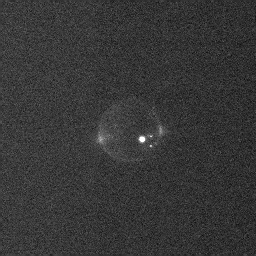
|
Io in Eclipse, Movie
- Click the image above for a larger view
 Movie Download Options
Movie Download Options
Caption:
Glowing spots of hot lava and ethereal auroral emissions are highlighted against blackness in this sequence of 48 frames from NASA's Cassini spacecraft, which show Jupiter's moon Io in the darkness of the giant planet's shadow.
The sequence was recorded over a two-hour interval that spanned nearly an entire eclipse on Jan. 1, 2001. Although no sunlight shines on the moon during an eclipse, two types of glows can be seen. The bright points of light are the glows of hot lava from active volcanoes. The brightest is the volcano Pele, which appears to be erupting steadily despite its great intensity. To the right of Pele and slightly above it is a pair of bright spots associated with the volcano Pillan, the source of a major eruption in 1997. NASA's Galileo spacecraft and Hubble Space Telescope saw that 1997 eruption of Pillan dwarf the energy output from neighboring Pele, but Pillan's eruption has waned over the past 30 months to the pair of small hot spots seen here. Another volcano, seen below and to the right of Pele, varies on a time scale of days. This sequence of images illustrates the great variations in intensity and longevity of Io's volcanic eruptions.
The second type of glow seen on Io during eclipse is a set of faint, diffuse emissions due to atmospheric auroras. Similar to the aurora borealis and aurora australis on Earth, Io's auroras are caused by the collisions of charged particles with gases in Io's tenuous atmosphere. A faint ring encircles the moon, while brighter glows are concentrated near the moon's equator. These equatorial glows are seen here gradually shifting clockwise in location as the eclipse progresses, due to the changing orientation of Jupiter's magnetic field. This is a new result which confirms that these visible auroras, like their counterparts seen at ultraviolet wavelengths, are caused by electrical currents that flow between Io and Jupiter.
The original images were taken through a clear filter of Cassini's narrow-angle camera from a distance of over 10 million kilometers (6.3 million miles), with a resolution of 61 kilometers (40 miles) per pixel. The images have been cropped and processed to remove scattered light.
Background Info:
Cassini is a cooperative project of NASA, the European Space Agency and the Italian Space Agency. The Jet Propulsion Laboratory, a division of the California Institute of Technology in Pasadena, Calif., manages Cassini for NASA's Office of Space Science, Washington, D.C.
Cataloging Keywords:
| Name | Value | Additional Values |
|---|---|---|
| Target | Jupiter | Io |
| System | Jupiter | |
| Target Type | Planet | Satellite |
| Mission | Cassini-Huygens | Galileo, Hubble Space Telescope (HST) |
| Instrument Host | Cassini Orbiter | Galileo Orbiter, Hubble Space Telescope |
| Host Type | Orbiter | Space Telescope |
| Instrument | Imaging Science Subsystem (ISS) | |
| Detector | Narrow Angle Camera | |
| Extra Keywords | Atmosphere, Collision, Eclipse, Grayscale, Magnetosphere, Movie, Shadow, Ultraviolet, Visual, Volcano | |
| Acquisition Date | ||
| Release Date | 2001-02-05 | |
| Date in Caption | 2001-01-01 | |
| Image Credit | NASA/JPL/University of Arizona | |
| Source | photojournal.jpl.nasa.gov/catalog/PIA02882 | |
| Identifier | PIA02882 | |
